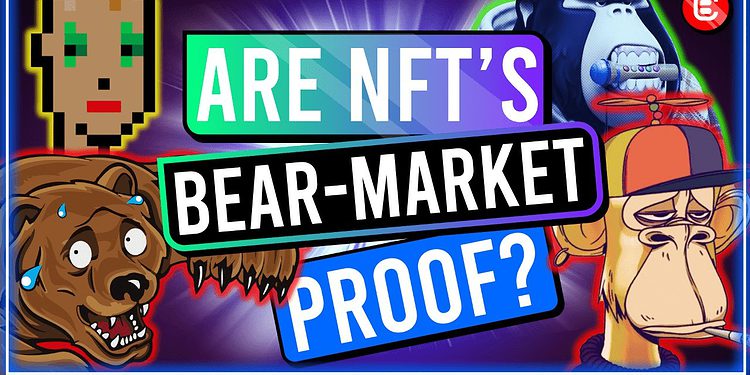- NFT sales volumes on OpenSea reached record highs in January 2022
- New investors are recognizing the NFT business model
- NFT trading volumes perform better when the market is stable and less volatile
There’s more to non-fungible tokens (NFTs) than meets the eye as the new market continues to defy crypto “normality”. It’s no surprise NFTs are blasting through the roof, given JPEGs are developing as an uncommon way to address digital assets. Nobody would have thought NFTs would outperform fundamentally strong altcoins – but we guess they were wrong!
The second coming of the NFT bull run still awes crypto maximalists, because NFTs are turning out to be a safe bet when the crypto market starts acting up. In addition, NFTs are getting recognition and validation across every industry. And that adds up to what is now a booming NFT space!
The data is developing a narrative of NFTs becoming a preferred hedge against an indecisive crypto market. So why are NFTs bear-proof?
The heated volume battle
NFT trade volumes in 2021 have heated up but nothing compared to what’s happening in 2022. If OpenSea’s monthly trade volume reached $3.4 billion in August 2021, January 2022 is likely to shatter that record by a landslide. Sales volumes on OpenSea are expected to reach $5 billion by the end of January, providing more upside momentum for alternative marketplaces on other blockchain networks like Solana.
Wallet activity is also spiking. Compared to the November 2021 low, over a million unique addresses have used OpenSea. And that’s just scratching the surface of how the NFT boom is taking shape.
Coincidently – or not – NFT sales started to ramp up when the crypto market was declining. But there’s no real correlation between August 2021 and January 2022 in terms of market sentiment. If anything, the conditions couldn’t be any different. Yet, NFT activity increase does follow search volumes – Google NFT searches are correlated to a surge in trading volume.
Are NFTs really a hedge?
Regardless of what we want to believe, NFTs are also affected by market actions. For example, they don’t perform well during high volatility periods because, particularly for Ethereum, high volatility equals high gas prices. It just doesn’t make sense to sell NFTs when you would end up paying much more for the gas than for the NFT. But when volatility decreases, and token prices are capitulating near the bottom, NFTs can easily become bear-proof.
SuperFarm’s co-founder, Ellio, told Crypto Banter that NFTs could work as a hedge during market downturns as long as “ETH doesn’t nuke”. Again, this implies that NFTs are worthwhile to investors as long as the price of Etheruem stays the same, dismissing volatility but suggesting stability is necessary.
However, Ethereum prices do not correlate with the demand for NFTs. If anything, while Etheruem has fluctuated as much as 50% downwards, NFTs volumes have been steady with minor peaks. They show a negative correlation. We haven’t yet tested the apocalyptic NFT premise implied by Ellio, and we hope we never will.
Data shows that demand for NFTs has always been there. When markets crash, NFTs continue to rise, while selling demand is similarly low compared to other periods. And the increased acceptance of NFTs into the public space is driving the hype.
But also remember that Etheruem is not alone. OpenSea has a compatible decentralized competitor in LooksRare, and the Solana ecosystem has reached a landmark of $1 billion in total NFT sales. While this might seem like futile developments, they’re not, because they build on the bigger NFT demand narrative!
Culturally validated!
Blue-chip NFTs such as Bored Ape Yacht Club have led the NFT market bounce. (Of course, it’s not a recovery if it never died out, but there was a rally.) NFT floor prices have risen as the value of ETH has decreased. Investors are placing their bets that floor prices will remain the same as the market recovers – because NFTs are not anchored to ETH, remember?
And blue-chip NFTs are getting more recognition within popular culture. Projects like Bored Ape Yacht Club are even getting airtime on The Tonight Show. And that’s a big big deal for an industry that’s gained momentum in just a single year!
Yuga Labs, Bored Ape Yacht Club’s parent company, has been valued at $5 billion. This helps reinforce and validate the status of NFTs as a sustainable and approved business model. All the while, celebs like Eminem, Neymar Jr., and Serena Williams are proud APEs. Need we say more?
But if you’re still not sure why NFTs are turning into JPEG gold, then consider this: JP Morgan has acknowledged that NFTs could have a more significant impact on the Ethereum network than DeFi. Quite a bold claim to make especially given DeFi’s use cases.
Banter wisdom
NFTs can be seen as a hedge against a bear market because, when NFTs run, they run to the moon. But NFTs are also more illiquid than any other digitally transacted asset. As a result, there are no bear markets in NFTs, just an illiquid market by default. And that’s worrying, especially for projects that have not yet reached blue chip status.
NFTs could potentially be a hedge against a bear market, but only if the entire market doesn’t nuke. Then it’s a different story. Only blue-chip tokens, if any, could outlast a true bear market. We believe that your exposure to NFTs should be calculated. Don’t follow the hype train – that would be a great way to crash. Practice extreme caution when investing in NFTs, because you don’t want to be overexposed when demand for a particular project suddenly drops!






